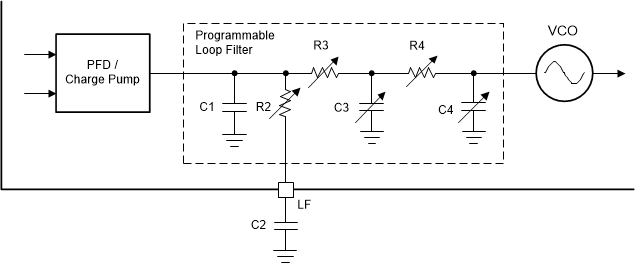SNAS751 December 2023 LMK5C33414A
PRODUCTION DATA
- 1
- 1 Features
- 2 Applications
- 3 Description
- 4 Pin Configuration and Functions
- 5 Specifications
- 6 Parameter Measurement Information
-
7 Detailed Description
- 7.1 Overview
- 7.2 Functional Block Diagram
- 7.3
Feature Description
- 7.3.1 Oscillator Input (XO)
- 7.3.2 Reference Inputs
- 7.3.3 Clock Input Interfacing and Termination
- 7.3.4 Reference Input Mux Selection
- 7.3.5 Hitless Switching
- 7.3.6 Gapped Clock Support on Reference Inputs
- 7.3.7 Input Clock and PLL Monitoring, Status, and Interrupts
- 7.3.8
PLL Relationships
- 7.3.8.1 PLL Frequency Relationships
- 7.3.8.2 Analog PLLs (APLL1, APLL2, APLL3)
- 7.3.8.3 APLL Reference Paths
- 7.3.8.4 APLL Phase Frequency Detector (PFD) and Charge Pump
- 7.3.8.5 APLL Feedback Divider Paths
- 7.3.8.6 APLL Loop Filters (LF1, LF2, LF3)
- 7.3.8.7 APLL Voltage-Controlled Oscillators (VCO1, VCO2, VCO3)
- 7.3.8.8 APLL VCO Clock Distribution Paths
- 7.3.8.9 DPLL Reference (R) Divider Paths
- 7.3.8.10 DPLL Time-to-Digital Converter (TDC)
- 7.3.8.11 DPLL Loop Filter (DLF)
- 7.3.8.12 DPLL Feedback (FB) Divider Path
- 7.3.9 Output Clock Distribution
- 7.3.10 Output Channel Muxes
- 7.3.11 Output Dividers (OD)
- 7.3.12 SYSREF/1-PPS
- 7.3.13 Output Delay
- 7.3.14 Clock Outputs (OUTx_P/N)
- 7.3.15 Glitchless Output Clock Start-Up
- 7.3.16 Clock Output Interfacing and Termination
- 7.3.17 Output Synchronization (SYNC)
- 7.3.18 Zero-Delay Mode (ZDM)
- 7.3.19 Time Elapsed Counter (TEC)
- 7.4 Device Functional Modes
- 7.5 Programming
-
8 Application and Implementation
- 8.1 Application Information
- 8.2 Typical Application
- 8.3 Best Design Practices
- 8.4 Power Supply Recommendations
- 8.5 Layout
- 9 Device and Documentation Support
- 10Revision History
- 11Mechanical, Packaging, and Orderable Information
Package Options
Mechanical Data (Package|Pins)
- RGC|64
Thermal pad, mechanical data (Package|Pins)
- RGC|64
Orderable Information
7.3.8.6 APLL Loop Filters (LF1, LF2, LF3)
APLL3 supports a programmable loop bandwidth from 100 Hz to 10 kHz (typical range), and APLL1 or APLL2 supports a programmable loop bandwidth from 100 kHz to 1 MHz (typical range). The loop filter components can be programmed to optimize the APLL bandwidth depending on the reference input frequency and phase noise. The LF1, LF2, and LF3 pins each require an external C2 capacitor to ground. See the suggested values for the LF1, LF2, and LF3 capacitors in Pin Configuration and Functions.
Figure 7-22 shows the APLL loop filter structure between the PFD/charge pump output and VCO control input.
 Figure 7-22 Loop Filter Structure of Each APLL
Figure 7-22 Loop Filter Structure of Each APLL